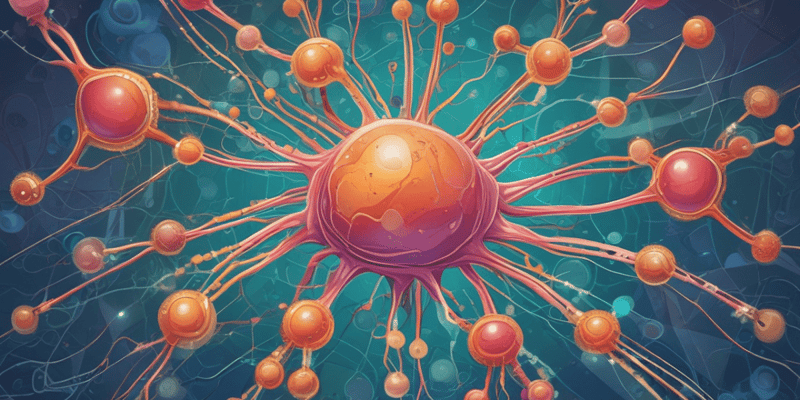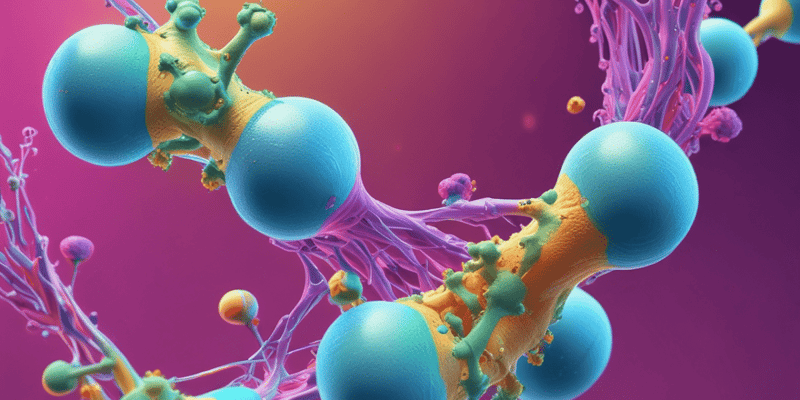29 Questions
Where do androgen, glucocorticoid, and mineralocorticoid receptors bind to their respective hormones?
In the cytoplasm
What is the primary function of thyroid hormones in the body?
Increase of metabolic rate in various cell types
How do steroid and thyroid hormones pass through the cell membrane?
Through passive diffusion
What is the role of an activated hormone-receptor complex in the nucleus?
It acts as a transcription factor
Where are estrogen, progesterone, and thyroid hormone receptors primarily located?
In the nucleus
What is the source of vitamin D3 in vertebrates?
Skin, in response to sunlight
What is the primary messenger involved in the cAMP signaling pathway?
cAMP
What is the outcome of Protein Kinase A phosphorylating glycogen synthetase?
Glycogen synthesis stops
What is the function of the CRE sequence in the promoter region of DNA?
It regulates the transcription of specific genes
What is the outcome of adrenaline binding to ß adrenergic receptors in muscle cells?
Glycogen breakdown increases
What is the role of the catalytic subunit of cAMP-activated Protein Kinase A?
It phosphorylates the CREB protein
What is the net effect of Protein Kinase A on blood glucose levels?
It increases blood glucose levels
What is the role of Ca++/Calmodulin-dependent protein kinases in muscle contraction?
Phosphorylating the myosin protein and stimulating the interaction between actin–myosin
What is the function of Ca+2 ATPase channels in the plasma membrane?
To actively remove free calcium from the cytosol into the lumen of organelles
What is the effect of low extracellular Ca2 concentrations on the Ca+2 receptor channel?
It closes the Ca+2 receptor channel
What is the role of Calmodulin in the cell?
To bind to Ca++ and act on kinases or as activators of kinases
What is the effect of Ca++/Calmodulin-dependent protein kinases on transcription factors?
They phosphorylate transcription factors such as CREB
What is the purpose of the mechanisms that protect against high Ca2 concentrations in the extracellular area?
To maintain low intracellular Ca2 concentrations
What is the role of Adenylate cyclase in the cAMP pathway?
Converts ATP to cAMP
What is the effect of caffeine on cAMP levels in the cell?
Decreases phosphodiesterase activity
What is the role of G protein-coupled receptors in the cAMP pathway?
Interacts with ligands to activate Adenylate cyclase
What is the effect of Protein Kinase A on phosphodiesterase?
Activates phosphodiesterase
What is the function of Protein Kinase A in the cAMP pathway?
Phosphorylates other molecules inside the cell
What is the effect of Nitric oxide on the smooth muscle and endothelial cells of the coronary vessels?
It causes relaxation in the smooth muscle and endothelial cells, allowing a greater amount of blood to flow to the heart muscle.
What is the function of cAMP in the olfactory receptor signaling pathway?
It opens cyclic nucleotide-gated channels, leading to an increase in intracellular sodium and calcium levels.
What is the role of guanylate cyclase in the cGMP signaling pathway?
It forms cGMP, increasing its intracellular levels.
What is the effect of CREB transcription factor on gene expression?
It leads to the transcription of various genes.
What is the source of nitric oxide in the body?
It is produced from arginine amino acid.
What is the effect of binding of acetylcholine to endothelial cells on nitric oxide production?
It increases intracellular Ca2 levels and nitric oxide synthetase, producing NO.
Study Notes
Intracellular Receptors
- Hydrophobic and lipophilic steroid and thyroid hormones pass through the cell membrane by passive diffusion
- Some bind to receptors in the cytoplasm, while others cross the nuclear membrane and bind to receptors in the nucleus
- Androgen, glucocorticoid, and mineralocorticoid receptors are located in the cytoplasm
- Estrogen, progesterone, thyroid hormone, and vitamin receptors are located in the nucleus
Signal Transduction
- Activated hormone-receptor complex can act as a transcription factor by binding to special DNA sequences (hormone response element, HRE) in the nucleus
- Unlike cell surface receptors, intracellular receptors generally exert their effects directly without using a secondary messenger
Steroid Hormones
- Steroid hormones, such as corticosteroids, are produced in the adrenal gland and influence the metabolism of many types of cells
- Steroid sex hormones, such as testosterone, estrogen, and progesterone, are made in the testes and ovaries
- Vitamin D3 is synthesized in the skin in response to sunlight and regulates Ca2+ metabolism
cAMP Signaling
- The ligand interacts with the G-protein-coupled receptor (GPCR) and activates the enzyme Adenylate cyclase (effector protein) in the membrane
- Adenylate cyclase converts ATP to cAMP to activate protein kinase A (target)
- Protein kinase A performs phosphorylation of other molecules inside the cell
- cAMP levels in the cell are reduced by the conversion of cAMP+H2O to AMP with the phosphodiesterase enzyme
cAMP Signaling in Muscle Cells
- Adrenaline in muscle cells binds to β adrenergic receptors, increasing cAMP and activating protein kinase A
- Protein kinase A phosphorylates and activates phosphorylase kinase, which breaks down glycogen to glucose
- Glycogen synthesis stops, and glucose levels in the blood increase
cAMP Signaling in Gene Transcription
- The transcription factor CREB (CRE binding protein) initiates the transcription of specific genes
- The catalytic subunit of cAMP-activated Protein Kinase A detaches and passes into the nucleus and activates the CREB protein by phosphorylating
- CREB transcription factor leads to transcription of various genes (DNA → mRNA)
cGMP Signaling
- cGMP is formed by guanylate cyclase and degraded by cGMP phosphodiesterase
- cGMP is involved in visual signal transmission in vertebrates
- Nitric oxide (NO) and ANP (atrial natriuretic peptide) increase intracellular cGMP levels by activating guanylate cyclase
Nitric Oxide Signaling
- Nitric oxide is produced from arginine amino acid by nitric oxide synthetase (NOS) enzyme
- NO can easily enter the cell by diffusion through the cell membrane
- NO causes relaxation in the smooth muscle and endothelial cells of the coronary vessels, allowing a greater amount of blood to flow to the heart muscle
- NO stimulates the aggregation of platelets, playing a role in coagulation
Calcium Signaling
- One of the Ca/Calmodulin-dependent protein kinases stimulates muscle contraction by phosphorylating the myosin protein and stimulating the interaction between actin–myosin for muscle contraction
- Other Ca/Calmodulin-dependent protein kinases (CaM kinases) phosphorylate various metabolic enzymes, ion channels, and transcription factors (CREB)
- They stimulate the release of neurotransmitters in the central nervous system
This quiz covers the mechanisms of intracellular receptors and signal transduction, including the binding of hormones to receptors in the cytoplasm and nucleus.
Make Your Own Quizzes and Flashcards
Convert your notes into interactive study material.
Get started for free



